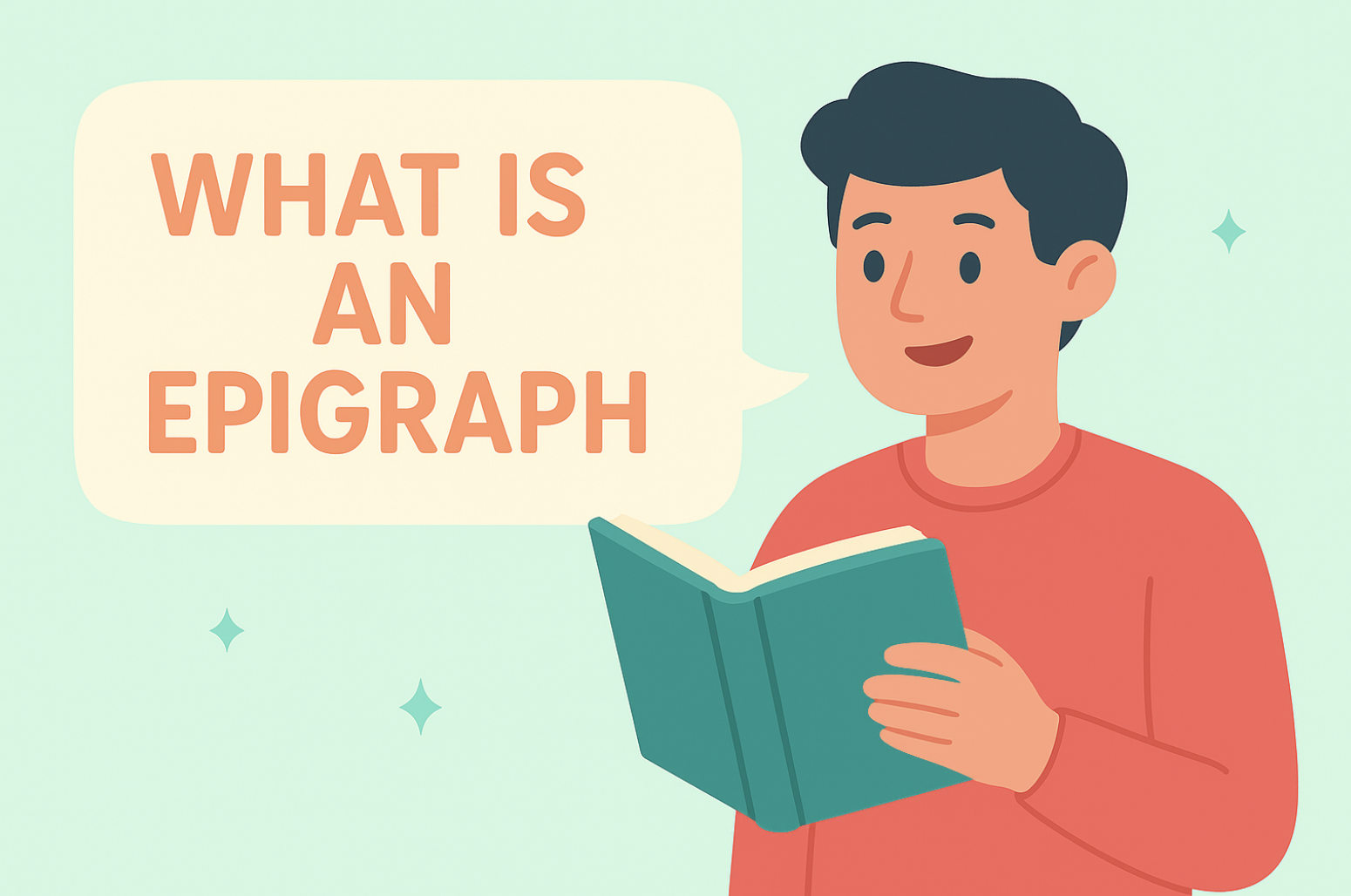Ever notice how some books sneak in a tiny, mysterious quote right before the first page of the story? It’s like a secret handshake between the author and the reader—a little teaser that sets the mood or drops a hint about what’s coming. That sneaky snippet has a fancy name: an epigraph. But if you’ve ever flipped past it wondering, What is an epigraph, anyway? You’re not alone.
Think of an epigraph as the literary equivalent of a movie trailer or a cryptic fortune cookie message—short, intriguing, and packed with meaning. It’s a tiny doorway inviting you in, whispering secrets before the plot even begins.
In this article, we’re unlocking the mystery of the epigraph: what it really is, why authors love to use it, and how these little gems can change the way you experience a book. Get ready to uncover this clever literary trick!
What Is an Epigraph? The Tiny Quote with a Big Job
What is an epigraph, exactly? Think of it as the literary appetizer before the main course—the bite-sized teaser that prepares your brain and tickles your curiosity before the story unfolds. It’s usually a short quote, a snippet of poetry, or a clever line borrowed from another work, placed right at the beginning of a book or a chapter. But don’t confuse it with a prologue or a dedication—those are their own beasts. A prologue dives into story details before the main narrative starts, while a dedication is the author’s shout-out to friends, family, or maybe their favorite coffee shop. The epigraph, on the other hand, is a little message in a bottle, washing up on the shore of the first page to set the mood or hint at the themes ahead.
In literature, an epigraph plays a neat role, too. It’s more than just decoration or a quirky flourish—it’s part of a long tradition of writers borrowing, nodding to, or responding to other works. So, what is an epigraph in literature beyond the book? It’s a kind of literary conversation starter, linking the new story with older ideas, cultures, or philosophies. Whether it’s a line from a famous poet, a proverb from ancient times, or a witty remark from a fellow author, the epigraph enriches the reading experience by layering extra meaning right from the get-go.
So, while small in size, an epigraph has a big job: to intrigue, foreshadow, and sometimes even challenge you, all before the first chapter turns. It’s the subtle nudge saying, “Hey, pay attention—there’s more to this story than meets the eye.”
Your Publishing Journey Awaits – Start NowWhat Is an Epigraph in Literature? How It Works Behind the Scenes
So, what is an epigraph in a book, really? Picture it as the “literary hype man” standing just offstage, whispering to the audience, “Trust me, this story’s about to get good.” Usually, you’ll find epigraphs right at the very front—before the title page, sometimes before the first chapter—formatted as a small block of text, often italicized or set apart with quotation marks. They’re short and sweet, designed to catch your eye without stealing the spotlight.
But why do authors bother with these little quotes? What is the purpose of an epigraph? Well, epigraphs serve several clever roles behind the scenes. First, they set the mood—imagine opening a book with a haunting line about loss, or a cheeky quote about love gone wrong. It immediately puts you in the right emotional frame of mind. Second, they can foreshadow events or themes to come, dropping subtle hints that reward attentive readers. Third, they offer commentary—sometimes wry, sometimes profound—that adds a new layer of meaning or irony to the story.
Another cool trick is that epigraphs often create connections with other texts or ideas. Authors might borrow a famous phrase, a line from a poem, or even a snippet of ancient wisdom to place their work within a broader conversation. It’s like saying, “Hey, I’m standing on the shoulders of giants here.” And sometimes, the epigraph’s message is bold and unmistakable—a clear clue or a thematic hammer smashing down on the reader’s head.
Of course, epigraphs don’t always shout their intentions. Some are subtle, mysterious, or even playful, making you pause and wonder what the heck the quote has to do with the story. Others hit you like a lightning bolt, leaving you nodding in recognition before you’ve even turned the first page.
In short, the epigraph in a book is that slick little opening act—quiet but powerful, teasing you with just enough to get hooked. It’s a crafty tool authors use to enrich the reading experience and invite you to look deeper. So next time you crack open a book, don’t skip the epigraph—it might just be the best spoiler-free teaser you’ll ever read.
What Is an Epigraph Example? A Few Famous (and Fun) Inspirations
Asking yourself: “What is an epigraph example that really sticks with readers?” Let’s get into a few famous—and fun—ones that show just how versatile these tiny quotes can be.
The Great Gatsby
First up, take the classic from The Great Gatsby by F. Scott Fitzgerald. The book opens with this gem:
“Then wear the gold hat, if that will move her; If you can bounce high, bounce for her too, Till she cry ‘Lover, gold-hatted, high-bouncing lover, I must have you!’”
—Thomas Parke D’Invilliers
This epigraph sets a flashy, almost theatrical mood right from the start, hinting at Gatsby’s dazzling—but ultimately hollow—pursuit of love and status. It’s like the perfect teaser trailer for the Jazz Age drama you’re about to witness.
Frankenstein
Now, for a different flavor, check out Mary Shelley’s Frankenstein. The epigraph here quotes from Paradise Lost:
“Did I request thee, Maker, from my clay To mould Me man? Did I solicit thee From darkness to promote me?”
This somber, philosophical line immediately signals the novel’s deep themes of creation, responsibility, and rebellion. It’s the literary equivalent of a serious eyebrow raise, telling readers to expect heavy questions about science and ethics.
Slaughterhouse-Five
And for a quirky twist, how about the epigraph from Kurt Vonnegut’s Slaughterhouse-Five? It’s a simple line from an anti-war song:
“All this happened, more or less.”
Short, cheeky, and mysterious, it sets the tone for a story that plays fast and loose with time and truth. Vonnegut’s epigraph winks at readers, saying, “Brace yourself for a wild ride.”
Each of these epigraph examples perfectly captures a different purpose: mood-setting, thematic hinting, irony, or playful mischief. The epigraph isn’t just decoration; it’s a clever way authors set the stage and invite readers to think deeper, laugh harder, or brace for impact before the first page even turns.
The Purpose of an Epigraph: Why Authors Can’t Resist Them
So, what is the purpose of an epigraph? Simply put, it’s a nifty literary tool authors use to add flavor, depth, and a dash of mystery before the story even begins. An epigraph can set the tone, offer a thematic clue, or spark a reader’s curiosity, kind of like a secret handshake between writer and reader.
For authors, it’s a creative way to connect their work to bigger ideas, other texts, or emotions they want to evoke. For readers, it acts as a tiny emotional or intellectual primer, tuning your brain to the vibes you’re about to encounter. That subtle nudge can make you pause, reflect, or even chuckle, adding a layer of richness that goes beyond the plot.
Epigraphs enrich the reading experience by weaving in extra meaning, sometimes hinting at themes or conflicts, sometimes offering irony or contrast. They invite you to look closer, think deeper, and feel more intensely. In a way, an epigraph is like the literary seasoning sprinkled on top of a story—just a pinch, but enough to transform the whole flavor.
In short, authors can’t resist epigraphs because they’re the perfect little spice that teases, tempts, and prepares readers for the narrative feast ahead. So next time you see one, don’t skip it—it might just be the secret ingredient that makes the whole book unforgettable.
The Epigraph’s Last Word
Epigraphs might be small, but they pack a surprising punch, setting the mood, dropping hints, or just adding a splash of cleverness before the story even starts. They’re the quiet little gems that invite you to think, feel, and get curious, all in a few words.
So next time you open a book, don’t just skip over that mysterious quote at the beginning. Give it a moment—it’s the author’s way of winking at you, saying, “Get ready, something good is coming.” And hey, why not try writing your own epigraph? Who knows, maybe your next brilliant quote will be the perfect literary appetizer for someone else’s story.
After all, every great book deserves a little tasty teaser. Happy reading—and happy quoting!
FAQs – What is an Epigraph?
Q1: Is an epigraph a quote?
Yes, an epigraph is usually a quote, but it can also be a short poem, a line from another text, or even a brief phrase. It serves as a thematic introduction to a book or chapter.
Q2: Can you write your own epigraph?
Absolutely! Writers can create original epigraphs to set the tone or offer insight. While many use existing quotes, an original epigraph can be just as powerful and meaningful.
Q3: What is the difference between an epigraph and an epilogue?
An epigraph is a brief quote or passage placed at the beginning of a book or chapter, while an epilogue is a concluding section at the end of a book that provides closure or additional information about the story.
Q4: Do you need permission to use an epigraph?
It depends. If the quote is from a public domain work or is very short, permission might not be necessary. However, for longer or copyrighted material, it’s best to seek permission to avoid legal issues.
Q5: Does the epigraph go before or after the dedication?
Typically, the epigraph appears after the dedication page and before the main text or first chapter. It acts as a thematic or mood-setting introduction following the dedication. There aren’t strict rules, but good epigraphs are concise, relevant to the work’s themes, and carefully chosen. They’re usually formatted distinctively (italicized or indented) and properly credited.







